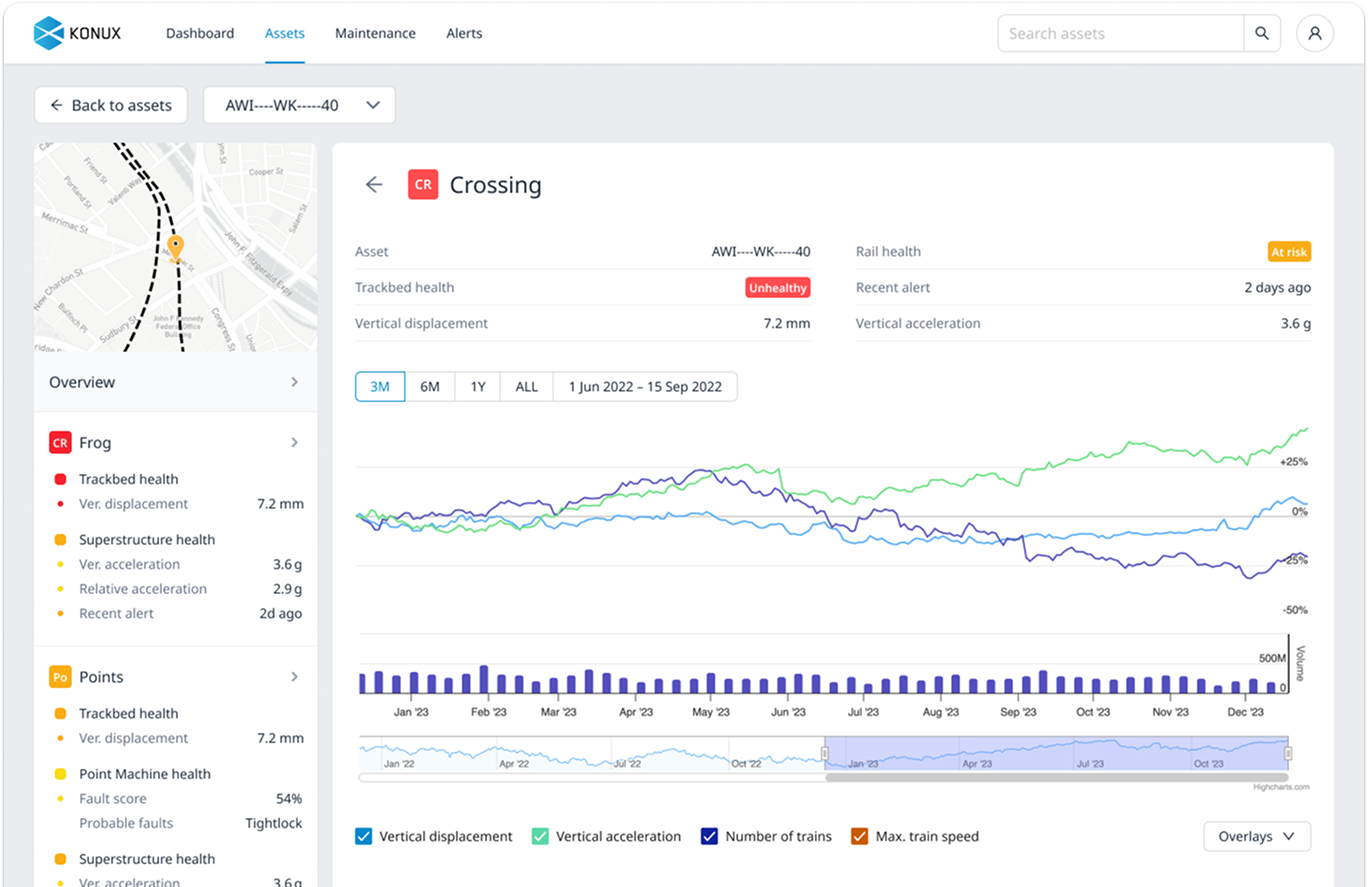Konux is a German AI scale-up transforming railway operations with intelligent monitoring solutions. Using AI, Machine Learning, and IoT sensors, Konux continuously tracks railway conditions, analyzes real-time data, and delivers actionable insights to engineers. This enables railway operators to predict infrastructure wear, optimize maintenance schedules, and enhance the reliability and efficiency of rail transport.

My role
As a Product Designer, I focused on solving complex design challenges in the railway industry across the German, UK, Spanish, and Japanese markets. My work involved designing intuitive UI for data analysis, visualising complex technical processes, and crafting UX that streamline decision-making for railway operators and engineers.
Challenges
- 1Engineers often perform unnecessary maintenance and inspections, causing budget overruns, traffic delays, and inefficient resource use. Without precise monitoring, critical issues are missed, while unplanned work disrupts operations. Excessive manual checks increase safety risks and divert staff from strategic tasks, making it harder to balance reliability, efficiency, and costs.
- 2A large volume of data often leads to significant time spent on analysis and decision-making. While this data is valuable, it lacks clear prioritization and actionable recommendations aligned with the realities of daily operations and budget planning for maintenance and component replacement.
- 3While crucial for decision-making, large data volumes require extensive analysis yet lack clear priorities and actionable insights. Without structured guidance, engineers struggle to address urgent issues efficiently, leading to wasted resources and suboptimal maintenance planning.
Holistic view
A single railway track node consists of multiple components, such as the Points, Frog, Point Machine and others. To make informed decisions, engineers need not only the overall condition of each component but also detailed parameters like vertical displacement and wheel trajectory. Our installed device captures these data. My task was to design how this data would be presented to users. The solution needed to be not only intuitive but also scalable, as the volume of data would continue to grow each year.

First iteration
After several iterations and discussions with stakeholders and users, we conducted usability testing, which led to this version emerging as the best solution. It presents detailed data for all components while also highlighting the most critical information about the track node, ensuring engineers can quickly grasp both granular insights and the bigger picture for better decision-making. Additionally, the solution is designed to scale seamlessly, allowing for the integration of more data as system complexity and information volume grow.

Insights instead of raw data
During interviews with engineers from different countries, I noticed a common pattern. Almost all of them mentioned that they lacked insights. They often don’t have the time to analyze raw data and instead prefer clear action-oriented instructions on what needs to be done and where. To address this, we collaborated with data engineers to develop a component based recommendations. Each one is data-driven and provides a clear priority, indicating which part of the railway infrastructure should be addressed first.

Mobile App
To enable track inspection engineers to quickly record all detected issues, we developed an MVP of a mobile application. All data is stored in a central database and automatically synchronized with the client’s data.
Traffic
One of our clients approached us with a critical issue: a single train running just five minutes late could trigger delays of 10–15 minutes for others. These cascading disruptions could eventually impact the entire railway network, potentially leading to a complete standstill. Our users needed a way to track the entire chain of events—from the initial cause of a delay to its full ripple effect across the system—allowing them to analyze root causes and mitigate future disruptions more effectively.

Konux Traffic — a solution that enables users to track the entire chain of events, from the first delayed train to the resolution of the issue. It determines where and how often delays happen, highlighting trigger events and their impact across the network to enable railway operators to improve punctuality.

To test the solution, several interactive prototypes were created, each revealing the weaknesses of different approaches. The final prototype, refined through these iterations, was then implemented in production.
Immersion is the Key to Effective User Experience
To truly understand the domain and the needs of users, I didn’t just rely on research behind a screen—I went into the field. As part of the Konux team, I actively participated in the installation process, securing 16 devices directly onto the railway tracks. You can spot them if you travel by train between Karlsruhe and Mannheim.













